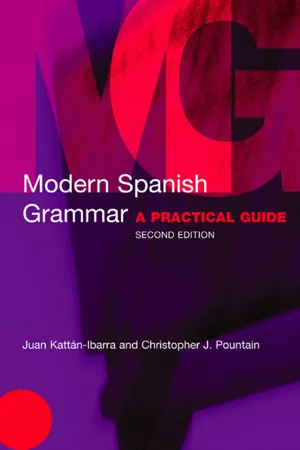
Modern Spanish Grammar
A Practical Guide
- 472 pages
- English
- ePUB (mobile friendly)
- Available on iOS & Android
Modern Spanish Grammar
A Practical Guide
About This Book
Modern Spanish Grammar: A Practical Guide is an innovative reference guide to Spanish, combining traditional and function-based grammar in a single volume.The Grammar is divided into two parts. The shorter section covers traditional grammatical categories such as word order, nouns, verbs and adjectives. The larger section is carefully organized around language functions and notions such as: giving and seeking information putting actions into context
* expressing likes, dislikes and preferences comparing objects and actions.All grammar points and functions are richly illustrated and information is provided on register and relevant cultural background. Written by experienced teachers and academics, the Grammar has a strong emphasis on contemporary usage. Particular attention is paid to indexing and cross-referencing across the two sections. This is the ideal reference grammar for learners of Spanish at all levels, from elementary to advanced. It will prove invaluable to those with little experience of formal grammar, as no prior knowledge of grammatical terminology is assumed and a glossary of terms is provided. The book will also be useful to teachers seeking back-up to functional syllabuses, and to designers of Spanish courses.
Frequently asked questions
Information
Part B
Functions
I
Social contact and communication strategies
29
Making social contacts
29.1 Greeting someone
29.2 Conveying greetings
29.2.1
| Recuerdos/saludos a Federico. | Regards to Federico. |

29.2.2
Table of contents
- Cover Page
- Half-Title Page
- Series Page
- Title Page
- Copyright Page
- Table of Contents
- Introduction
- Glossary
- Part A Structures
- Part B Functions
- Appendix: Table of common irregular verbs
- Bibliography
- Index of words and topics